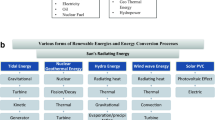Abstract
In the recent years, electricity production from renewable energy sources especially solar energy has progressed a great deal. Solar energy is a locally available renewable resource which is the most plentiful, unfailing and clean of all the renewable energy resources till date. A solar cell also called photovoltaic cell or PV is the technology used to convert energy from sunlight directly into electricity. As the PV market grows, it is becoming increasingly important to understand the energy performance of photovoltaic solar cells technologies. The purpose of this paper is to evaluate and compare the performance of crystalline silicon and thin film PV technologies with the DEA (data envelopment analysis) method in four states (considering payback period factor, total factors, technical and economic factors). The results indicate that in the three states where in “total factors”, “technical factors” and “economic factors” have been considered as performance factors, the mean of efficiency scores for crystalline silicon is higher than the mean of efficiency scores for thin-film. But in the state where in “payback period factor” has been considered as performance factor, the mean of efficiency score for Thin-film is higher than the mean of efficiency score for crystalline Silicon.








Similar content being viewed by others
References
M.H. Akhlaghi, M.R. Mohammadi, Dependence of photovoltaic performance of solvothermally prepared CdS/CdTe solar cells on morphology and thickness of window and absorber layers. J. Mater. Sci. 24(9), 3564–3574 (2013)
A. Balaska, A. Tahri, F. Tahri, A.B. Stambouli, Performance assessment of five different photovoltaic module technologies under outdoor conditions in Algeria. Renew. Energy 107, 53–60 (2017)
F. Bono, M. Giacomarra, The photovoltaic growth in the European union requires stronger RES support. J. Policy Model 38(2), 324–339 (2016)
S.C. Chang, C.Y. Liu, L.Y. Pan, Using DEA to evaluate operation efficiency of top 10 global solar photovoltaic companies. In Management Engineering Technology (PICMET), Portland International Conference on 2014 (IEEE, Portland, 2014), pp. 1877–1885
D.R. Criswell, R.G. Thompson, Data envelopment analysis of space and terrestrially-based large scale commercial power systems for Earth: a prototype analysis of their relative economic advantages. Sol. Energy 56(1), 119–131 (1996)
S. Ghosh, V.K. Yadav, V. Mukherjee, P. Yadav, Evaluation of relative impact of aerosols on photovoltaic cells through combined Shannon’s entropy and data envelopment analysis (DEA). Renew. Energy 105, 344–353 (2016)
K.T. Kim, D.J. Lee, S.J. Park, Y. Zhang, A. Sultanov, Measuring the efficiency of the investment for renewable energy in Korea using data envelopment analysis. Renew. Sustain. Energy Rev. 47, 694–702 (2015)
A. Mostafaeipour, M. Qolipour, K. Mohammadi, Evaluation of installing photovoltaic plants using a hybrid approach for Khuzestan province, Iran. Renew. Sustain. Energy Rev. 60, 60–74 (2016)
D.A. Quansah, M.S. Adaramola, G.K. Appiah., I.A. Edwin, Performance analysis of different grid-connected solar photovoltaic (PV) system technologies with combined capacity of 20 kW located in humid tropical climate. Int. J. Hydrogen Energy, 42, 4626–4635 (2016)
R. Ramanathan, Comparative risk assessment of energy supply technologies: a data envelopment analysis approach. Energy 26(2), 197–203 (2001)
T.S. Senthil, N. Muthukumarasamy, M. Kang, Improved performance of ZnO thin film solar cells by doping magnesium ions. J. Mater. Sci. 24(10), 3963–3969 (2013)
R. Siddiqui, R. Kumar, G.K. Jha, G. Gowri, M. Morampudi, P. Rajput, S. Lata, S. Agariya, B. Dubey, G. Nanda, S.S. Raghava, Comparison of different technologies for solar PV (Photovoltaic) outdoor performance using indoor accelerated aging tests for long term reliability. Energy 107, 550–561 (2016)
T. Sueyoshi, M. Goto, Photovoltaic power stations in Germany and the United States: a comparative study by data envelopment analysis. Energy Econ. 42, 271–288 (2014)
D.D. Wang, T. Sueyoshi, Assessment of large commercial rooftop photovoltaic system installations: evidence from California. Appl. Energy 188, 45–55 (2017)
Z. Xiaoping, L. Zhang, W. Jihuai, L. Jianming, F. Leqing, Enhancing photovoltaic performance of photoelectrochemical solar cells with nano-sized ultra thin Sb2S3-sensitized layers in photoactive electrodes. J. Mater. Sci. 24(6), 1970–1975 (2013)
L. Zhang, J. Wang, H. Wen, Z. Fu, X. Li, Operating performance, industry agglomeration and its spatial characteristics of Chinese photovoltaic industry. Renew. Sustain. Energy Rev. 65, 373–386 (2016)
X. Zhang, Y. Lin, B. Fang, Y. Lin, Y. Hong, J. Wu, Improved photovoltaic performance of CdS/CdSe co-sensitized solar cells by using calcined starch–ZnO mesoporous spheres. J. Mater. Sci. 26(5), 2955–2961 (2015)
Author information
Authors and Affiliations
Corresponding author
Rights and permissions
About this article
Cite this article
Haeri, A. Evaluation and comparison of crystalline silicon and thin-film photovoltaic solar cells technologies using data envelopment analysis. J Mater Sci: Mater Electron 28, 18183–18192 (2017). https://doi.org/10.1007/s10854-017-7764-y
Received:
Accepted:
Published:
Issue Date:
DOI: https://doi.org/10.1007/s10854-017-7764-y




